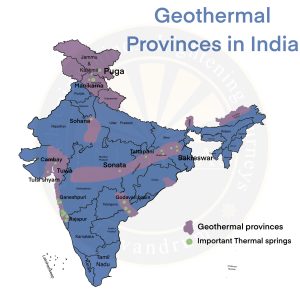- What is it?
- Geothermal energy is heat from the Earth’s interior, used for electricity generation and heating.
- Heat is sourced from molten rock (magma) beneath the Earth’s crust, largely due to radioactive decay.
- Advantages
- Renewable: Unlimited heat from Earth’s core.
- Clean Energy: Low CO₂ emissions compared to fossil fuels.
- Cost-Efficient in Some Areas: Used for heating homes, baths, and generating electricity.
- High Energy Yield: Modular expansion possible; competitive electricity costs.
- Disadvantages
- Location Specific: Usable only in areas with geothermal hotspots.
- H₂S Emissions: Releases hydrogen sulfide (“rotten egg” smell), which is toxic in large quantities.
- Environmental Concerns:
- Greenhouse gases (stored underground) may be released during drilling.
- Risks of triggering earthquakes due to structural alterations in Earth’s crust.
- Infrastructure Challenges:
- High setup costs ($2–$7 million per megawatt capacity).
- Energy cannot be transported long distances, requiring proximity to consumption sites.
- Sustainability Issues: Requires reinjection of water to maintain pressure and prevent resource depletion.
- Major Geothermal Sites in India
- Puga Field (Ladakh).
- Manikaran Field (Himachal Pradesh).
- Tattapani Field (Chhattisgarh).
- Godavari Graben.
- Western Thermal Provinces (Konkan, Sohna, Cambay).

